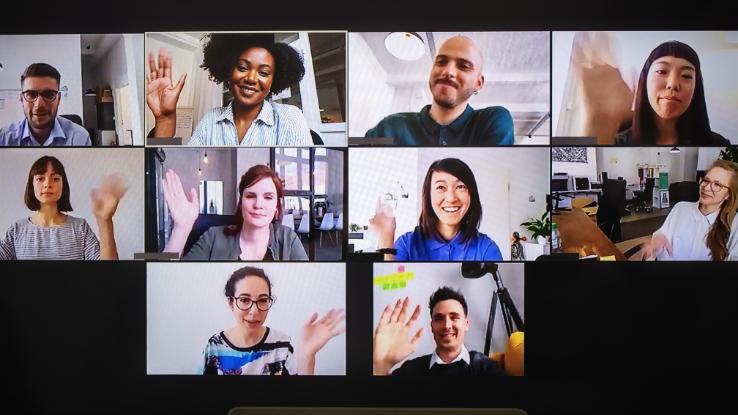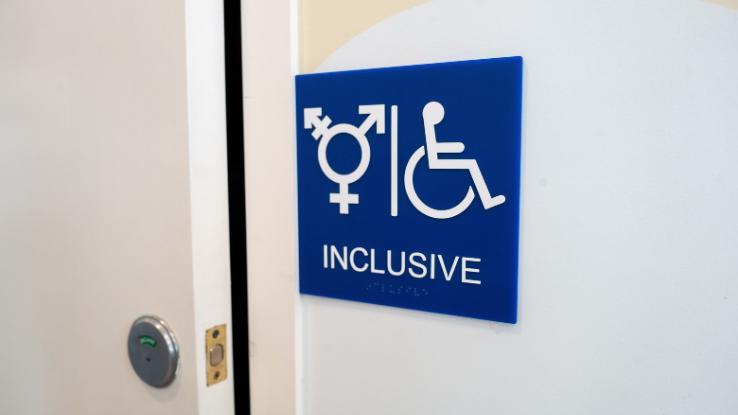8 Simple Ways You Can Make Your Workplace More LGBTQ+ Inclusive

Even though LGBTQ+ people have always been part of the workforce, many employers are now considering queer and trans folks’ specific needs for the first time. The year 2020 saw massive spikes the already growing diversity training industry. Both the Black Lives Matter movement and Supreme Court ruling protecting LGBTQ+ workers from discrimination pushed employers to reconsider how welcoming their workplaces are. Many companies sought the advice of outside experts to help them implement changes and reshape office culture, and these efforts have continued to gain traction in the last few years.
While some queer and trans workers experienced welcome (and long overdue) changes, others are still waiting for employers to rise to this new standard of workplace inclusivity. From hiring practices and staff trainings to offering inclusive parental leave and trans-affirming healthcare options, there’s a lot that can be done to make queer and trans employees not only feel more welcome but also feel safe and respected. Needless to say, cultivating a more inclusive workplace environment — whether in person or remotely — is essential, and we’ve rounded up some great ways to enact that necessary change.
1. Don’t Force Someone to Come Out at Work — and Don’t Make Assumptions
This one seems obvious, doesn’t it? Still, it bears repeating. When it comes to the first part of this, you should never out someone — at work or otherwise. In the workplace, deciding whether to be out or not often comes with a lot of concerns for many queer folks. In 2017, WNYC’s Nancy podcast found that many queer folks are “selectively out” at work for a number of reasons.

For one, being out might mean a myriad of frustrating, ill-informed questions from coworkers who “mean well” but aren’t particularly well-versed in queerness. In other instances, being out at work can be downright dangerous, and outing someone without their consent can lead not only to emotional turmoil but physical safety concerns as well. The Human Rights Campaign (HRC) backs up Nancy‘s anecdotal interviewee findings with hard facts: 46% of LGBTQ+ workers say they are closeted at work, which is only a 4% shift from 2008. Additionally, one in five LGBTQ+ workers reported that coworkers implied their manner of dress should be altered (made more or less feminine or masculine).
Needless to say, workplace cultures on the whole need to be overhauled. This means that you should take care to respect LGBTQ+ coworkers’ boundaries; don’t out them and don’t make assumptions about closeted or openly queer coworkers and their lives, especially if you’re extrapolating based on their appearance or gender presentation. “I’ve had to come out at every job I’ve ever had because I look so ‘straight,'” Nikki Levy, creator of Don’t Tell My Mother!, told The Muse. Remember: There’s no one way to look or be gay; there’s no one way to look or be nonbinary. And the statement holds true for virtually any other identifier. Respect people for who they are, and let them be the authority and voice on what they choose to share of themselves.
2. Educate Yourself and Invite Professional Speakers to Help Train Your Staff
While it’s important to listen to your LGBTQ+ coworkers, you shouldn’t expect them to educate you. For queer and trans folks, having to constantly explain their lived experiences is incredibly draining, to say the least. The emotional labor involved takes a toll, and they shouldn’t be expected to answer every (or any) question you have about gender or queerness. If your LGBTQ+ coworkers volunteer information or wish to share their experiences, listen to them — but don’t expect them to do the work for you.

While educating oneself is of utmost importance, it might also be great to get your whole workplace on the same page. That is, provide resources for employees to reference, hold unconscious bias training and invite LGBTQ+ speakers who professionally verse themselves in diversity and inclusion-related topics to share their knowledge with your workplace. Doing so is not just a way to make straight and cis coworkers better informed allies; taking definitive actions to make LGBTQ+ coworkers feel safe, respected and heard can do wonders for queer and trans folks’ mental health. The HRC found that 31% of LGBTQ+ workers feel unhappy or depressed at work, and while those feelings can stem from any number of origin points, fostering a more inclusive workplace, and ensuring that employees engage with that spirit regardless of their identities, can go a long way in protecting LGBTQ+ employees’ mental and physical health.
Need more resources for your workplace? Organizations like GLAAD offer tools and content that employees can use to educate themselves and that you can use to design company policies and practices.
3. Provide Equal Benefits for Queer Couples and Trans-Affirming Healthcare Benefits
Frustratingly, when it comes to health benefits, LGBTQ+ folks and their particular concerns are often overlooked. FOLX Health, a newly launched healthcare service for LGBTQ+ folks, directly addresses the barriers and stigma queer and trans folks face in the organization’s mission statement, noting, “We’re tired of seeing queer and trans folx treated as problems, not people.” Figuring out benefits and all things healthcare-related can be stressful enough, but it can be even more difficult to navigate when benefits plans aren’t designed with you and your family in mind.

First, when it comes to adding dependents and partners to employee health insurance, be sure that the coverage for queer employees and their families is equivalent to that which your straight employees are receiving. Another overarching change? When examining your workplace’s language surrounding life insurance, health benefits and retirement policies, be sure to use inclusive language that accounts not just for queer partnerships, but all genders, too. For example, parental leave was long dubbed “maternity leave,” with the assumption that the parent who was giving birth and/or caring for the newborn child would be a cis woman in a heterosexual relationship. Here, the changes are two-fold: Use neutral language, like “parent” instead of traditionally gendered terms like “mother” and “father,” and be sure to offer an equal amount of leave for all partners, regardless of their gender, their partner’s gender or whether they carried the child or not. In general, remove gendered terminology from benefits information and use the neutral “they” pronoun instead of “he or she.”
Additionally, employers should make sure their policies and benefit selections provide support and coverage for the needs of transgender, nonbinary, agender and genderqueer folks. “There is an increasing number of individuals who self-identify as nonbinary when it comes to gender,” said Deborah Clegg, PhD, Drexel University‘s associate dean of research at the school’s College of Nursing and Health Professions. “As this increasing population continues to grow… we need to appreciate the health care struggles many individuals find when they approach institutions who are not educated about how to approach and treat their needs.”
Although it’s important to keep in mind that not all trans folks physically transition or want hormone replacement therapy (HRT), employers should help eliminate barriers to safe and affordable healthcare. If you’re not sure how to make these changes, consider hiring an LGBTQ+ equality consulting firm to help you get started.
4. Reexamine Your Hiring Practices
As you’re looking over your work policies, consider examining your hiring strategies as well. Examine your company’s job advertisements and other materials to see if you’re making any unintended assumptions about your job openings or the people who apply to them. Consider posting on job boards like Pink Jobs and the Transgender Job Bank; have your hiring team attend LGBTQ+ recruitment events; and find queer-inclusive networking opportunities, like Lesbians Who Tech + Allies, that are a good fit for your industry and your employees’ professional development.

You should also make explicit mention of your commitment to an unbiased hiring process and diversity in the workplace. During the interview process, do not make assumptions about a prospective candidate; remember, they might not feel comfortable coming out during the interview — or at all. Instead, make it a standard policy to discuss your company’s values and LGBTQ+-friendly policies. And, when it comes to drafting inclusive employment policies and job descriptions, be sure to review LGBTQ+-inclusive resources, such as this guide from the Transgender Law Center (TLC).
5. Support and Fund Employee Resource Groups
Forbes notes that a company’s “[Diversity and inclusion] efforts sometimes end up looking more like diversity hiring programs, without enough emphasis on equity and belonging once employees are in the door.” While reevaluating hiring processes is a must, companies should also actively empower their employees on an ongoing basis. One great way to do this — and to show a commitment to long-term change — is to establish employee resource groups (ERGs).

If you’re unfamiliar with ERGs, they’re defined as “voluntary, employee-led groups that foster a diverse, inclusive workplace aligned with organizational mission, values, goals, business practices, and objectives.” According to Diversity Best Practices, ERGs — or, as they were once known, Workplace Affinity Groups — were first established in the 1960s in response to ongoing racism and discrimination in the workplace.
By advocating for more inclusive policies, professional development events and more, ERGs can radically shift how a workplace empowers and retains its employees. Not only do these spaces help give employees a voice regardless of their role in the organization, but providing funding and support for employees’ concerns can also make a workplace safer and more welcoming for all. Best of all, an ERG can meet over Zoom or in-person, which is great news for businesses that operate on a remote basis.
6. Normalize the Inclusion of Pronouns and Gender-Neutral Restrooms
Workplaces should cultivate an environment where folks of all genders are given the tools and support they need to succeed, free from anyone else’s judgments or preconceived notions. For trans, nonbinary, agender and genderqueer folks, traditionally gendered (and binary) spaces can be stressful to navigate — and, in some cases, unsafe. The key example of this? Restrooms. A simple way to address this concern is to offer gender-neutral, gender-inclusive and/or all-gender restrooms, all of which should include in-stall trash receptacles and sanitary products.

While many of us are working remotely, it can be tricky to find ways to create a more inclusive virtual workplace culture. But just because it’s difficult doesn’t mean there aren’t simple and meaningful ways to create lasting change and a more welcoming environment. One of the easiest ways to foster inclusivity is to encourage every member of your staff to include their pronouns in email signatures, Slack bios, Zoom names and HR profiles and on other applicable platforms. Doing so normalizes the practice and takes the spotlight off of trans, nonbinary, agender and genderqueer folks to always be the ones to start the conversation or share their pronouns first.
It’s important to remember that we can’t assume or know a person’s gender just by looking at them; there are many genders — and some folks don’t identify with any gender. Pronouns help to describe a person’s gender identity, but that doesn’t mean pronoun use is the same for everyone. That is, nonbinary folks might use they/them pronouns, but they also might use he/him, she/her or ze/zir pronouns, just to name some examples. If you misgender someone or don’t use their pronouns, be sure to correct yourself, but don’t linger over it — the last thing a queer or trans person wants is to make you feel better about a mistake. “Remember, intention is not impact,” Out notes. “The best apology is one that doesn’t make excuses or invalidate the other person’s feelings.”
7. Stand Up for Your Coworkers
Whenever you see or hear discrimination in the workplace, you should say something about it. For example, according to the HRC, a staggering 53% of LGBTQ+ workers report overhearing jokes about lesbian or gay people. If you hear homophobic or transphobic jokes — even if they aren’t told in front of your LGBTQ+ coworkers — call the offender out, and report the instance(s) to HR. Bigoted remarks do incalcuable damage, and it shouldn’t be just those who are being attacked who stand up to offenders.

“If you hear a coworker misgender a trans person or call them the wrong name outside that person’s presence, call them out, if you know the trans person is out to them and it is safe to do so,” says Charlie Arrowood, the Director of Name & Gender Recognition at Transcend Legal. The bottom line: Speaking up, and standing up for others, are what create lasting and meaningful change.
8. And, Yes, Support Pride Month Events, but in a More Aware Way
Every June, LGBTQ+ folks and their allies celebrate Pride Month — and with Pride Month comes a wave of corporations rainbow-ifying their logos and rolling out stacks of rainbow merch. This shift is a double-edged sword: In some ways, Pride Month being more visible in the mainstream creates wider acceptance at the workplace and outside of it. On the other hand, “corporate Pride” also commodifies queerness and erases Pride’s origins as a riot.

Sure, seeing one’s straight and cis coworkers marching in Pride is fun, but it isn’t the ultimate badge of allyship many assume it to be. It’s important to remember that Pride isn’t about demonstrating allyship (or, you know, just partying) — it’s about being supportive, standing up for your peers, celebrating the LGBTQ+ community and honoring Pride’s origins as a force for progress in the face of police brutality and rampant discrimination. Make sure your company is committed to supporting the LGBTQ+ community year-round — not just in June when it’s trendy (and profitable).





